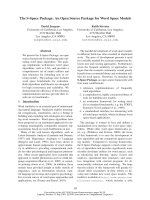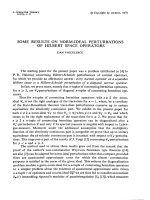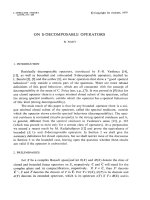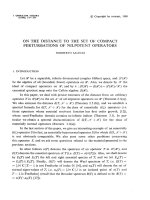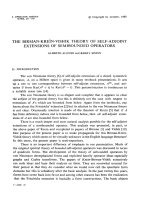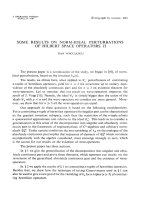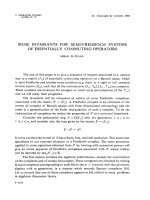Báo cáo toán học: "Franklin’s argument proves an identity of Zagier" pdf
Bạn đang xem bản rút gọn của tài liệu. Xem và tải ngay bản đầy đủ của tài liệu tại đây (90.5 KB, 5 trang )
Franklin’s argument proves an identity of Zagier
Robin Chapman
School of Mathematical Sciences, University of Exeter, Exeter, EX4 4QE, UK
Submitted: September 28, 2000; Accepted: November 9, 2000
Abstract
Recently Zagier proved a remarkable q-series identity. We show that this iden-
tity can also be proved by modifying Franklin’s classical proof of Euler’s pentagonal
number theorem.
Mathematics Subject Classification (2000): 05A17 11P81
1 Introduction
We use the standard q-series notation:
(a)
n
=
n
k=1
(1 − aq
k−1
)
where n is a nonnegative integer or n = ∞. Euler’s pentagonal number theorem states
that
(q)
∞
=1+
∞
r=1
(−1)
r
(q
r(3r−1)/2
+ q
r(3r+1)/2
). (1)
Recently Zagier proved the following remarkable identity
Theorem 1
∞
n=0
[(q)
∞
− (q)
n
]=(q)
∞
∞
k=1
q
k
1 − q
k
+
∞
r=1
(−1)
r
[(3r − 1)q
r(3r−1)/2
+3rq
r(3r+1)/2
]. (2)
This is [8, Theorem 2] slightly rephrased.
Equation (1) has a combinatorial interpretation. The coefficient of q
N
in (q)
∞
equals
d
e
(N) − d
o
(N)whered
e
(N) (respectively d
o
(N)) is the number of partitions of N into
an even (respectively odd) number of distinct parts. Franklin [4] showed that
d
e
(N) − d
o
(N)=
(−1)
r
if N =
1
2
r(3r ± 1) for a positive integer r,
0otherwise.
the electronic journal of combinatorics 7 (2000), #R54 2
His proof was combinatorial. He set up what was almost an involution on the set of
partitions of N into distinct parts. This “involution” reverses the parity of the num-
ber of parts. However there are certain partitions for which his map is not defined.
These exceptional partitions occur precisely when N =
1
2
r(3r ± 1), and so account for
the nonzero terms on the right of (1). Franklin’s argument has appeared in numerous
textbooks, notably [1, §1.3] and [5, §19.11].
We show that Zagier’s identity has a similar combinatorial interpretation, which,
miraculously, Franklin’s argument proves at once.
The author wishes to thank George Andrews and Don Zagier for supplying him with
copies of [3] and [8], and also an anonymous referee for helpful comments.
2 Proof of Theorem 1
We begin by recalling Franklin’s “involution”. Let D
N
denote the set of partitions of N
into distinct parts and let D =
∞
N=0
D
N
.Forλ ∈D
N
let N
λ
= N, n
λ
be the number of
parts in λ and m
λ
be the largest part of λ (if λ is the empty partition of 0 let m
λ
=0).
Then
(q)
∞
=
λ∈D
(−1)
n
λ
q
N
λ
. (3)
Let λ be a non-empty partition in D. Denote its smallest part by a
λ
. If the parts
of λ are λ
1
>λ
2
>λ
3
> ··· let b = b
λ
denote the largest b such that λ
b
= λ
1
+1− b
(so that λ
k
= λ
1
+1− k if and only if 1 ≤ k ≤ b). If λ ∈Dis not exceptional (we
shall explain this term shortly), then we define a new partition λ
as follows. If a
λ
≤ b
λ
we obtain λ
by removing the smallest part from λ and then adding 1 to the largest a
λ
parts of this new partition. If a
λ
>b
λ
we obtain λ
by subtracting 1 from the b
λ
largest
parts of λ and then appending a new part b
λ
to this new partition.
For example take the partition λ illustrated in Figure 1.
Figure 1: the partition λ
the electronic journal of combinatorics 7 (2000), #R54 3
Then a
λ
= 2 and b
λ
=3. Asa
λ
≤ b
λ
then λ
is obtained by removing the smallest
part of λ and adding 1 to its largest two parts. We get the partition λ
illustrated in
Figure 2. This time a
λ
= 3 and b
λ
=2,andweobtainλ
by subtracting 1 from the
Figure 2: the partition λ
two largest parts of λ
, and creating a new smallest part of 2. This operation reverses
the construction of λ
from λ,andsoλ
= λ.
The exceptional partitions are those for which this procedure breaks down. We regard
the empty partition as exceptional, also we regard those for which n
λ
= b
λ
and a
λ
= b
λ
or
b
λ
+1. If λ is not exceptional, then neither is λ
and λ
= λ and (−1)
n
λ
= −(−1)
n
λ
.Thus
on the right side of (3) the contributions from non-exceptional partitions cancel. The
non-empty exceptional partitions are of two forms: for each positive integer r we have
λ =(2r − 1, 2r −2, ,r+1,r) for which n
λ
= r, m
λ
=2r −1andN
λ
=
1
2
r(3r −1), and
we have λ =(2r, 2r −1, ,r+2,r+1) for which n
λ
= r, m
λ
=2r and N
λ
=
1
2
r(3r +1).
Thus from (3) we deduce (1).
If λ ∈Dis non-exceptional, then either n
λ
= n
λ
− 1, in which case m
λ
= m
λ
+1, or
n
λ
= n
λ
+1,inwhichcasem
λ
= m
λ
− 1. In each case m
λ
+ n
λ
= m
λ
+ n
λ
. It follows
that in the sum
λ∈D
(−1)
n
λ
(m
λ
+ n
λ
)q
N
λ
the terms corresponding to non-exceptional λ cancel and so we get only the contribution
from exceptional λ.Thus
λ∈D
(−1)
n
λ
(m
λ
+ n
λ
)q
N
λ
=
∞
r=1
(−1)
r
[(3r − 1)q
r(3r−1)/2
+3rq
r(3r+1)/2
]. (4)
This sum occurs in (2), which will follow by analysing the left side of (4).
We break this into two sums. The first
λ∈D
(−1)
n
λ
m
λ
q
N
λ
the electronic journal of combinatorics 7 (2000), #R54 4
is dealt with in [3, Theorem 5.2]. We repeat their argument. The coefficient of q
N
in
(q)
∞
− (q)
n
is the sum of (−1)
n
λ
over all λ ∈D
N
having a part strictly greater than n.
Such a λ is counted for exactly m
λ
different n so that
∞
n=0
[(q)
∞
− (q)
n
]=
λ∈D
(−1)
n
λ
m
λ
q
N
λ
. (5)
For each positive integer k,
−q
k
1 − q
k
(q)
∞
=(1− q)(1 − q
2
) ···(1 − q
k−1
)(−q
k
)(1 − q
k+1
) ···.
The coefficient of q
N
in this product is the sum of (−1)
n
λ
over all λ ∈D
N
having k as
a part. Such a λ occurs for n
λ
distinct k, and summing we conclude that
−(q)
∞
∞
k=1
q
k
1 − q
k
=
λ∈D
(−1)
n
λ
n
λ
q
N
λ
. (6)
Combining (4), (5) and (6) gives (2).
3 Another identity
Subbararo [7] (see also [2, 6]) has used essentially the above argument to prove a related
identity. As before Franklin’s involution proves that
λ∈D
(−1)
n
λ
x
m
λ
+n
λ
q
N
λ
=1+
∞
r=1
(−1)
r
[x
3r−1
q
r(3r−1)/2
+ x
3r
q
r(3r+1)/2
]. (7)
By elementary combinatorial considerations the left side of (7) can be shown to equal
∞
r=0
(x)
r+1
x
r
and so
∞
r=0
(x)
r+1
x
r
=1+
∞
r=1
(−1)
r
[x
3r−1
q
r(3r−1)/2
+ x
3r
q
r(3r+1)/2
]. (8)
For details see [2, 6, 7]. An alternative method of proving (8) is outlined in [1] and
presented in more detail in [8]. Zagier [8] deduces (2) from (8), essentially by carefully
differentiating with respect to x and setting x =1.
the electronic journal of combinatorics 7 (2000), #R54 5
References
[1] G. E. Andrews, The Theory of Partitions, Addison-Wesley, 1976 (reprinted Cam-
bridge University Press, 1998).
[2] G. E. Andrews, ‘Two theorems of Gauss and allied identities proved arithmetically’,
Pacific J. Math., 41 (1972), 563–578.
[3] G. E. Andrews, J. Jim´enez-Urroz, & K. Ono. ‘Bizarre q-series identities and values
of certain L-functions’, preprint.
[4] F. Franklin, ‘Sur le d´eveloppement du produit infini (1−x)(1−x
2
)(1−x
3
)(1−x
4
) ’,
C. R. Acad. Sci. Paris, 92 (1881), 448–450.
[5] G.H.Hardy&E.M.Wright,An Introduction to the Theory of Numbers (5th ed.),
Oxford University Press, 1979.
[6] D. E. Knuth & M. S. Paterson, ‘Identities from partition involutions’, Fibonacci
Quart, 16 (1978), 198–212.
[7] M. V. Subbarao, ‘Combinatorial proofs of some identities,’ Proceedings of the Wash-
ington State University Conference on Number Theory 80–91, Washington State
Univ., 1971.
[8] D. Zagier, ‘Vassiliev invariants and a strange identity related to the Dedekind eta-
function’, Topology,toappear.
